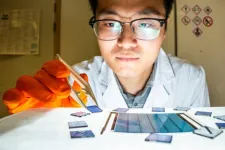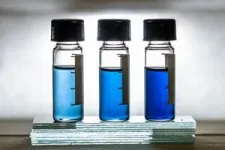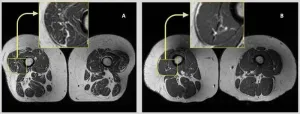(Press-News.org) Large-scale production of organic solar cells with high efficiency and minimal environmental impact. This can now be made possible through a new design principle developed at Linköping University, Sweden. In the study, published in the journal Nature Energy, the researchers have studied molecule shape and interaction in organic solar cells.
“With electrification and the development of AI, we will probably see a significant increase in the world’s energy needs. That electricity needs to come from environmentally sustainable sources if we are to slow down climate change at the same time,” says Feng Gao, professor of optoelectronics at LiU.
One green energy source in the focus of researchers globally is solar cells. As a complement to traditional silicon solar cells, several different alternative variants are being developed. One of the most promising technologies is based on electrically conductive plastics – organic electronics.
The advantage of organic solar cells is that they are comparatively cheap and easy to manufacture. In addition, they are lightweight and flexible, which means that they could be placed on windows, indoors or on clothes to power personal electronics. Organic solar cells are already on the market today and their share is expected to increase.
The efficiency of organic solar cells is catching up with traditional solar cells and they can convert about 20 percent of the sun’s rays into electricity. The high efficiency is the result of several years of intensive materials research and studies of the interaction between the molecules in the material, the so-called morphology.
Organic solar cells are produced in a physical mixture which is then placed on a substrate and the solvent in the mixture evaporates. However, the chemical solution contains toxic and environmentally hazardous substances.
“To realise mass production of organic solar cells, with printed technologies for example, on a large scale, we need to find methods that don’t use toxins. Otherwise, it’s not good for the environment or for those working in the factories,” says Feng Gao.
His research team has now, together with colleagues in China and the United States, managed to crack the code for producing efficient organic solar cells with several different environmentally friendly solvents.
“To choose the right solvent, it’s important to understand the entire solar cell manufacturing process. This includes knowing the initial structures of the solution, observing the dynamic processes during evaporation and checking the final structure of the solar cell film,” says Rui Zhang, researcher at the Department of Physics, Chemistry and Biology at LiU and lead author of the article published in Nature Energy.
What the Linköping researchers have done is map the molecular interaction between the materials transporting the electrons and the solvent itself by using a series of advanced synchrotron X-ray and neutron techniques. Thanks to this, the researchers were then able to develop a design principle that works for many different harmless solvents. In the long run, they hope that even water can act as a solvent.
According to the researchers, understanding the link between morphology and performance in organic solar cells is a major challenge, as they need to investigate the ultra-fast movement of electrons (the charge transport) from the material that releases electrons to the receiving material. Those processes occur within nanoscale structures and at molecular interfaces. According to Feng Gao, the road to environmentally sustainable organic solar cells is now open.
“Thanks to a toxin-free manufacturing method, we now have a much greater chance of commercialising the technology on a larger scale.”
END
How non-toxic and efficient solar cells can be produced
2024-12-04
ELSE PRESS RELEASES FROM THIS DATE:
Eating high-processed foods impacts muscle quality
2024-12-04
CHICAGO – A diet high in ultra-processed foods is associated with higher amounts of fat stored inside thigh muscles, regardless of the amount of calories consumed or level of physical activity, according to a study being presented today at the annual meeting of the Radiological Society of North America (RSNA). Higher amounts of intramuscular fat in the thigh could also increase the risk for knee osteoarthritis.
The use of natural and minimally processed ingredients in many modern diets has decreased, more often being replaced with ingredients that have been industrially processed, artificially flavored, colored or chemically altered.
Foods ...
Study Exposes High Injury Rates in Transgender Women
2024-12-04
CHICAGO – A new study found that injury rates among transgender women are significantly higher than injuries among cisgender women, based on radiological imaging. The findings will be presented today at the annual meeting of the Radiological Society of North America (RSNA).
‘Cisgender’ is a term used to describe people whose gender identity matches the sex they were assigned at birth, while ‘transgender’ describes people whose gender identity differs from the sex they were assigned ...
Massive asteroid impacts did not change Earth’s climate in the long term
2024-12-04
Two massive asteroids hit Earth around 35.65 million years ago, but did not lead to any lasting changes in the Earth’s climate, according to a new study by UCL researchers.
The rocks, both several miles wide, hit Earth about 25,000 years apart, leaving the 60-mile (100km) Popigai crater in Siberia, Russia, and the 25-55 mile (40-85km) crater in the Chesapeake Bay, in the United States - the fourth and fifth largest known asteroid craters on Earth.
The new study, published in the journal Communications Earth & Environment, found no evidence of a lasting shift in climate in the 150,000 years that followed the impacts.
The researchers inferred the past climate ...
Milestone in defining electrical units
2024-12-04
The precise measurement of electrical resistance is essential in industrial production or electronics – for example, in the manufacture of high-tech sensors, microchips and flight controls. “Very precise measurements are essential here, as even the smallest deviations can significantly affect these complex systems”, explains Professor Charles Gould, a physicist at the Institute for Topological Insulators at the University of Würzburg (JMU).
The scientist now for the first time have experimentally implemented a so-called quantum resistance standard that can operate without an externally applied magnetic field. “In physics, ...
70% of young people with long Covid recover within two years
2024-12-04
Most young people who were confirmed to have long Covid three months after a positive PCR test had recovered within 24 months, finds a new study led by UCL researchers.
The Children and young people with Long Covid (CLoCK) study, published in Nature Communications Medicine and funded by the National Institute for Health and Care Research (NIHR), is the world’s largest longitudinal cohort study on long Covid in children.
The researchers, led by Professor Sir Terence Stephenson and Professor Roz Shafran (both UCL Great Ormond Street ...
A new catalyst can turn methane into something useful
2024-12-04
CAMBRIDGE, MA -- Although it is less abundant than carbon dioxide, methane gas contributes disproportionately to global warming because it traps more heat in the atmosphere than carbon dioxide, due to its molecular structure.
MIT chemical engineers have now designed a new catalyst that can convert methane into useful polymers, which could help reduce greenhouse gas emissions.
“What to do with methane has been a longstanding problem,” says Michael Strano, the Carbon P. Dubbs Professor of Chemical Engineering at MIT and the senior author of the study. “It’s a source of carbon, and we want to keep it out ...
Climate-ready crop
2024-12-04
A team from the University of Illinois has engineered potato to be more resilient to global warming showing 30% increases in tuber mass under heatwave conditions. This adaptation may provide greater food security for families dependent on potatoes, as these are often the same areas where the changing climate has already affected multiple crop seasons.
“We need to produce crops that can withstand more frequent and intense heatwave events if we are going to meet the population’s need for food in regions most at ...
The heart has its own ‘brain’
2024-12-04
New research from Karolinska Institutet and Columbia University shows that the heart has a mini-brain – its own nervous system that controls the heartbeat. A better understanding of this system, which is much more diverse and complex than previously thought, could lead to new treatments for heart diseases. The study, conducted on zebrafish, is published in Nature Communications.
The heart has long been thought to be controlled solely by the autonomic nervous system, which transmits signals from the brain. The heart’s neural network, which is embedded in the superficial layers of the heart wall, has been considered a simple structure that relays the signals from the ...
Mexican American women less likely to take stroke prevention medications as prescribed
2024-12-04
Research Highlights:
An analysis of more than 1,300 stroke survivors found that women were less likely than their male counterparts to take medications, such as cholesterol-lowering statins and blood thinning medications to prevent blood clots, to prevent recurrent strokes, as prescribed.
Mexican American women were three times more likely to report not taking cholesterol-lowering medications as prescribed than Mexican American men in the study.
Women who were older or married were also more likely to miss taking prescribed doses. Researchers suggest ...
20th century lead exposure damaged American mental health
2024-12-04
DURHAM, N.C. -- In 1923, lead was first added to gasoline to help keep car engines healthy. However, automotive health came at the great expense of our own well-being.
A new study calculates that exposure to car exhaust from leaded gas during childhood altered the balance of mental health in the U.S. population, making generations of Americans more depressed, anxious and inattentive or hyperactive. The research estimates that 151 million cases of psychiatric disorder over the past 75 years have resulted from American children’s exposure to lead.
The findings, from Aaron Reuben, a postdoctoral scholar in neuropsychology ...






